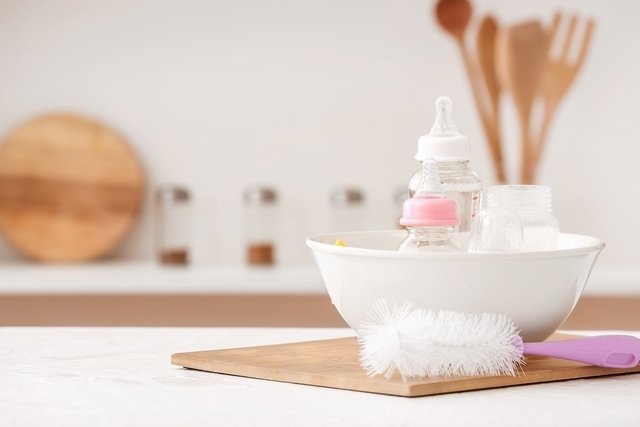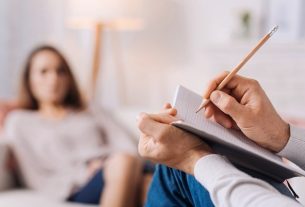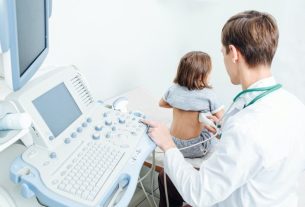To sterilize bottles and pacifiers, different techniques can be used, such as boiling in hot water, sterilizing in the microwave or using an electric sterilizer, or chemical sterilization with bleach when other techniques are not available.
Cleaning and sterilizing the bottle, silicone nipple and pacifier is important to avoid infections in the baby, which can cause diarrhea or vomiting, as the baby’s immune system is not completely mature to fight infections.
Therefore, the bottle must first be cleaned and then sterilized, always before using it for the first time and at least once a day, during the first 12 months of the baby’s life.

Bottle cleaning
The first step before sterilizing the bottle is to clean it, following the steps below:
- Separate all parts of the bottle, the lid, the nipple, the screw, the rings, the bottle and the valves, if you have them;
- Place these parts in a basin with enough warm water to completely cover the parts of the bottle;
- Add 10 drops of neutral detergent;
- Leave the parts of the bottle to soak in this water with detergent for at least 20 minutes;
- Scrub all parts of the bottle, with a bottle-cleaning brush that reaches the bottom of the bottle, removing all dirt and leftover milk;
- Rinse all parts well in warm or hot water, being careful not to burn yourself;
- Let the parts of the bottle dry naturally, placing them on kitchen paper;
- Wash the basin and bottle brush with running water and warm or hot detergent, after each use and leave to dry naturally on a kitchen towel.
Before cleaning the bottle, it is important to wash your hands with water and neutral soap and dry with a clean, dry towel.
Furthermore, it is important to check if there are any cracks in the bottle nipple, thread or the bottle itself. If you have them, it is advisable to discard them, as bacteria can grow in these cracks.
Bottles and pacifiers must be cleaned after each use, and any amount of breast milk or formula remaining in the bottle must be discarded.
How to remove yellow from baby bottles
To remove the yellowing or bad smell from a bottle or pacifier, you can place the parts of the bottle in a container containing enough water to cover the bottle, 2 tablespoons of bleach and 2 tablespoons of bicarbonate. of sodium.
Leave the bottle to soak in this solution for 1 hour. After that, everything must be washed with clean running water.
But beyond that, it is still important to sterilize everything, completely eliminating all germs, from the bottle and pacifier.
Step by step on how to sterilize a bottle
After cleaning the bottle, it must be sterilized to eliminate bacteria or germs that can cause infections in the baby. Sterilization must be done at least once a day, during the baby’s first year of life.
Bottle sterilization can be done using different techniques, which are:
1. Sterilization in boiling water
Separate the parts of the bottle and pacifiers, and add them to a pan.
Add enough water to cover all parts and bring to a boil. After the water starts to boil, it must be left on the heat for another 5 to 10 minutes.
Then, remove the parts of the bottle and pacifiers with clean tweezers or tongs or with properly sanitized hands and place everything to dry naturally, on top of a sheet of kitchen paper.
Hot water sterilization can also be done to sanitize the bottle brush and the basin in which the bottle is cleaned.
2. Sterilization in the microwave
To thoroughly clean the bottle and pacifier in the microwave, you need to place everything inside a glass bowl, a microwave-safe plastic container or in a microwave sterilizer, which you can buy at pharmacies or health food stores. babies and children.
The procedure is carried out by placing the utensils in the container and covering them with water, placing them in the microwave at full power for around 8 minutes, or according to the product manufacturer’s instructions.
Then, remove the bottle with the help of a clean tongs or tweezers and let the bottles, nipples and pacifiers dry naturally, on a sheet of kitchen paper.
3. Sterilization in the electric sterilizer
Sterilizing the bottle in the electric sterilizer must be carried out following the manufacturer’s instructions, which come on the product box.
In general, sterilization lasts around 7 to 8 minutes, and the device has the advantage of less wear on objects, prolonging their useful life.
After the process, you can leave the utensils to dry in the appliance before storing them in a tightly closed container.
4. Sterilization with bleach
Bleach sterilization can be done when all other methods described above are not available.
To use bleach to sterilize the bottle, mix 2 teaspoons of unscented bleach in 16 glasses of water or 1 gallon of water in a clean, dry basin.
Then, soak the bottle parts or pacifiers in this solution for 2 minutes. After this time, remove the bottle and/or pacifiers with clean tweezers or tongs, and let them dry naturally on kitchen paper.
It is not necessary to rinse, as as it dries, the bleach breaks down, leaving no residue that can mix with breast milk or formula.
Care after sterilization
After cleaning and sterilizing the bottle and pacifiers, they must be allowed to dry naturally, placing the parts of the bottle and/or pacifier on a sheet of kitchen paper. In the case of an electric sterilizer, the bottle can dry in the device itself.
It is important to avoid drying baby’s utensils with any type of cloth, so that contamination by microorganisms does not occur and lint from the fabric does not remain on the objects.
Then, when they are dry, you should wash your hands with water and neutral soap, dry well, and put the parts of the bottle together and store it, without closing it completely, inside the kitchen cabinet in a clean, dry part that do not have food stored. A good option is in the part where the clean dishes are.
The bottle cleaning brush and basin should also be stored in a clean, protected place, such as a closed kitchen cabinet.
How often should you sterilize
Sterilization of pacifiers and bottles should always be done before using them for the first time and then once a day until the first year of life or whenever they fall on the floor or come into contact with dirty surfaces.
This procedure is important to prevent the development of bacteria or other microorganisms in the baby’s nipples, pacifiers and bottles, which can end up causing problems such as intestinal infections, diarrhea and cavities.
This is because the baby’s immune system is not yet fully matured to fight infections.
A good tip is to have at least 2 to 3 identical bottles and pacifiers so that when one is soaking or being sterilized, the other can be used.
What not to do
Some methods of cleaning that are not recommended when cleaning a baby’s bottle and pacifier are:
- Wash these containers with washing powder, as it is a very strong product and will leave a taste in the bottle and pacifier;
- Leave everything to soak in a basin, but without keeping everything covered by water. Placing a small plate on top of everything can ensure that everything really soaks;
- Wash the bottle and pacifier in the dishwasher along with other kitchen objects, as they may not be properly cleaned;
- Leave the bottle to soak with just water and a little detergent with the lid facing inward on the kitchen sink overnight;
- Dry the bottle and pacifier with a kitchen towel as they may leave lint that the child could swallow;
- Keep these objects still wet or damp in the kitchen cupboard as this can facilitate the proliferation of fungi that cannot be seen with the naked eye.
It is also not recommended to clean the bottle and pacifier only once a month or once a week, because traces of milk and saliva remain that promote the proliferation of microorganisms that cause illnesses in the baby.
How to clean the Styrofoam in a baby bottle
In addition to the bottle and pacifier, it is also important to clean the Styrofoam or thermal bag where the bottle is placed.
In this case, it is recommended to wash it daily with a soft sponge, a little detergent and 1 tablespoon of baking soda, which will help remove all traces of milk and microorganisms.
Then, let it dry naturally facing down, on a clean kitchen towel or, preferably, on a sheet of kitchen paper.
What type of bottle and pacifier to buy
The best bottles and pacifiers are those that do not contain bisphenol A, also known as BPA, and some types of phthalates, which are substances released when these objects come into contact with heat, and which can be toxic to the baby.
When the product does not contain this type of substance, it is easy to recognize, because it is usually written on the box of these products that it does not contain: DEHP, DBP, BBP, DNOP, DINP or DIDP.
The same rule applies to all the child’s other objects, such as plastic toys and rattles that they usually put in their mouth.

Sign up for our newsletter and stay up to date with exclusive news
that can transform your routine!
Warning: Undefined array key "title" in /home/storelat/public_html/wp-content/plugins/link-whisper-premium/templates/frontend/related-posts.php on line 12
Warning: Undefined array key "title_tag" in /home/storelat/public_html/wp-content/plugins/link-whisper-premium/templates/frontend/related-posts.php on line 13



